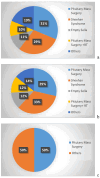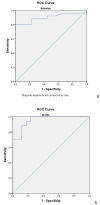The diagnosis and prevalence of hypoprolactinemia in patients with panhypopituitarism and the effects on depression and sexual functions
- PMID: 38700812
- PMCID: PMC11150180
- DOI: 10.1007/s11102-024-01393-0
The diagnosis and prevalence of hypoprolactinemia in patients with panhypopituitarism and the effects on depression and sexual functions
Abstract
Purpose: We aimed to investigate the prevalence and the diagnostic criteria of hypoprolactinemia in patients with panhypopituitarism and the effects of hypoprolactinemia on depression and sexual functions.
Materials and methods: Forty-eight patients with panhypopituitarism and 20 healthy volunteers were included. Basal hormone levels were measured and a TRH stimulation test was performed. For the evaluation of sexual functions, questionnaries of Female Sexual Functional Index (FSFI) for females and International Erectile Functional Index for males were performed to the subjects. Depressive symptoms were evaluated by Beck Depression Envontory score (BDI-II).
Results: The peak PRL response to TRH stimulation test at 5th percentile in the control group was 18.6 ng/ml in males and 41.6 ng/ml in females and accepted as the cut-offs for sufficient response of PRL. Prolactin was insufficient in 42(87.5%) patients. A basal PRL level of ≤ 5.7 ng/ml in males and 7.11 ng/ml in females was 100% specific in predicting an inadequate response to TRH stimulation test with 80% and 70% sensitivity respectively. A basal PRL level of ≥ 8.5 ng/dl in males was 100% specific and 76% sensitive, and in females a level of ≥ 15.2 ng/dl was 96% specific and 66% sensitive in predicting an adequate response to TRH. PRL deficient patients with panhypopituitarism had higher depression scores compared to the controls, lower sexual function scores in males.
Conclusion: PRL deficiency is prevalent among individuals with panhypopituitarism, with the potential to result in elevated depression scores in both sexes and impaired sexual functions in males. A basal PRL level seems to be sufficient for the diagnosis of hypoprolactinemia in routine clinical practice.
Keywords: Depression; Hypopituitarism; Hypoprolactinemia; Prolactin; Sexual functions; TRH stimulation test.
© 2024. The Author(s).
Conflict of interest statement
The authors declare no competing interests.
Figures



Similar articles
-
Diagnosis of hypoprolactinemia.Rev Endocr Metab Disord. 2024 Dec;25(6):985-993. doi: 10.1007/s11154-024-09896-8. Epub 2024 Jul 22. Rev Endocr Metab Disord. 2024. PMID: 39037546 Free PMC article. Review.
-
Hypoprolactinemia. Does it matter? Redefining the hypopituitarism and return from a mumpsimus : "Absence of proof is not the proof of absence".Rev Endocr Metab Disord. 2024 Dec;25(6):943-951. doi: 10.1007/s11154-023-09847-9. Epub 2023 Oct 25. Rev Endocr Metab Disord. 2024. PMID: 37875774 Review.
-
[Serum prolactin response to thyrotropin-releasing hormone in normal subjects and in patients with thyroid diseases (author's transl)].Nihon Naibunpi Gakkai Zasshi. 1975 Mar 20;51(3):161-5. doi: 10.1507/endocrine1927.51.3_161. Nihon Naibunpi Gakkai Zasshi. 1975. PMID: 808433 Japanese.
-
The relationship of changes in serum estradiol and progesterone during the menstrual cycle to the thyrotropin and prolactin responses to thyrotropin-releasing hormone.J Clin Endocrinol Metab. 1978 Dec;47(6):1296-302. doi: 10.1210/jcem-47-6-1296. J Clin Endocrinol Metab. 1978. PMID: 122427
-
Thyrotrophin, prolactin and growth hormone responses to TRH in barbiturate coma and in depression.Clin Endocrinol (Oxf). 1978 Jul;9(1):49-58. doi: 10.1111/j.1365-2265.1978.tb03571.x. Clin Endocrinol (Oxf). 1978. PMID: 98247
Cited by
-
Sheehan syndrome: a current approach to a dormant disease.Pituitary. 2025 Jan 25;28(1):20. doi: 10.1007/s11102-024-01481-1. Pituitary. 2025. PMID: 39863703 Free PMC article. Review.
-
Increased Cardiometabolic Risk in Men with Hypoprolactinemia: A Pilot Study.Biomolecules. 2024 Oct 20;14(10):1335. doi: 10.3390/biom14101335. Biomolecules. 2024. PMID: 39456268 Free PMC article.
-
Modern approach to bone comorbidity in prolactinoma.Pituitary. 2024 Dec;27(6):802-812. doi: 10.1007/s11102-024-01469-x. Epub 2024 Nov 14. Pituitary. 2024. PMID: 39541075 Review.
-
Could low prolactin levels after radiotherapy predict the onset of hypopituitarism?Rev Endocr Metab Disord. 2024 Dec;25(6):1013-1025. doi: 10.1007/s11154-024-09900-1. Epub 2024 Aug 22. Rev Endocr Metab Disord. 2024. PMID: 39172174 Free PMC article. Review.
-
Traumatic brain injury and prolactin.Rev Endocr Metab Disord. 2024 Dec;25(6):1027-1040. doi: 10.1007/s11154-024-09904-x. Epub 2024 Sep 3. Rev Endocr Metab Disord. 2024. PMID: 39227558 Review.
References
-
- Karaca Z, Unluhizarci K, Kelestimur F (2023) Hypoprolactinemia. Does it matter? Redefining the hypopituitarism and return from a mumpsimus: absence of proof is not the proof of absence. Rev Endocr Metab Disord - PubMed
MeSH terms
Substances
Supplementary concepts
LinkOut - more resources
Full Text Sources
Medical

